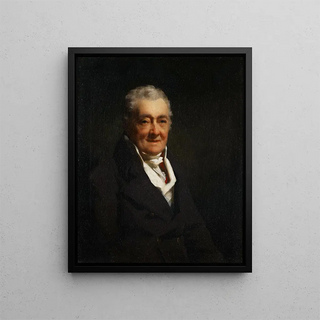Art print | E. Finlay Esquire - Sir Henry Raeburn


View from behind

Frame (optional)
The artwork "E. Finlay Esquire - Sir Henry Raeburn" is part of the rich heritage of 18th-century British painting. This captivating portrait, which delicately illustrates the stature and personality of Sir Henry Raeburn, draws the eye with its elegance and depth. The depiction of Finlay, a businessman of the era, invites viewers to immerse themselves in a world where portraiture was a privileged means of asserting social status. This painting, both intimate and majestic, manages to capture not only the physical appearance of its subject but also a deeper essence, that of a man rooted in his time and values.
Style and uniqueness of the work
The style of this piece is distinguished by meticulous attention to detail and masterful use of light. Raeburn, known for his ability to render textures and colors with remarkable precision, succeeds here in bringing his subject to life. The delicate shadows sculpting Finlay’s face add an almost three-dimensional quality to the canvas. The chosen palette, oscillating between warm tones and darker shades, creates a contrast that attracts the eye and emphasizes the gravity of the character. This portrait does not merely depict a man; it tells a story, that of an individual whose features are imbued with dignity and character. The pose, slightly relaxed but resolute, reflects a quiet confidence, a mirror of the Victorian era when the individual was at the center of artistic concerns.
The artist and his influence
Sir Henry Raeburn, an emblematic figure of Scottish painting, established himself as one of the most respected portraitists of his time. His technique, blending realism and idealization, influenced many artists who followed in his footsteps. By drawing inspiration from European masters while developing a style unique to himself, Raeburn created works that transcend simple portraiture to become living testimonies of British identity. His influence is felt not only in Scotland but also beyond borders, where his works continue to inspire generations of artists. Raeburn’s ability to capture

Matte finish

View from behind

Frame (optional)
The artwork "E. Finlay Esquire - Sir Henry Raeburn" is part of the rich heritage of 18th-century British painting. This captivating portrait, which delicately illustrates the stature and personality of Sir Henry Raeburn, draws the eye with its elegance and depth. The depiction of Finlay, a businessman of the era, invites viewers to immerse themselves in a world where portraiture was a privileged means of asserting social status. This painting, both intimate and majestic, manages to capture not only the physical appearance of its subject but also a deeper essence, that of a man rooted in his time and values.
Style and uniqueness of the work
The style of this piece is distinguished by meticulous attention to detail and masterful use of light. Raeburn, known for his ability to render textures and colors with remarkable precision, succeeds here in bringing his subject to life. The delicate shadows sculpting Finlay’s face add an almost three-dimensional quality to the canvas. The chosen palette, oscillating between warm tones and darker shades, creates a contrast that attracts the eye and emphasizes the gravity of the character. This portrait does not merely depict a man; it tells a story, that of an individual whose features are imbued with dignity and character. The pose, slightly relaxed but resolute, reflects a quiet confidence, a mirror of the Victorian era when the individual was at the center of artistic concerns.
The artist and his influence
Sir Henry Raeburn, an emblematic figure of Scottish painting, established himself as one of the most respected portraitists of his time. His technique, blending realism and idealization, influenced many artists who followed in his footsteps. By drawing inspiration from European masters while developing a style unique to himself, Raeburn created works that transcend simple portraiture to become living testimonies of British identity. His influence is felt not only in Scotland but also beyond borders, where his works continue to inspire generations of artists. Raeburn’s ability to capture






